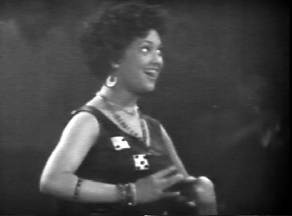
Hallelujah!It's particularly worth commenting on the musical side. The film gives, in some sections, a remarkably authentic representation of black entertainment and religous music in the 1920s, which no other film achieves. Unfortunately some of the sequences are rather Europeanised and over-arranged. For example, the outdoor revival meeting, with the preacher singing and acting out the 'Train to hell', is entirely authentic in style until the end, where he launches into the popular song 'Waiting at the End of the Road'. Similarly, an outdoor group of workers singing near the beginning of the film are saddled with a choral arangement of 'Way Down upon the Swanee River' (written by Stephen Foster, who never went anywhere near the South) - no black workers would sing that!.  The best sequence (and one which is of vital importance in the history of
classic jazz) is in the dancehall, where Nina Mae McKinney (left) gives a
stunning performance of 'Swanee Shuffle' - just the right sort of popular song;
although actually filmed in a New York studio using black actors, the sequence
gives the most accurate representation I've ever seen of a low-life black
dance-hall - part of the roots of classic jazz. Nothing else on film comes near
this: most Hollywood films sanitized black music out of all recognition; and
later, in the 1930s, when black artists began to show their real styles, jazz
had moved on to become more sophisticated and the whole style of behaviour had
changed. All this makes the film a unique document: and it's worth adding that
the soundtrack is a remarkable achievement, given the primitive equipment
available at the time, with a much wider range of editing and mixing techniques
than is generally thought to have been used so early on in
talkies.
The best sequence (and one which is of vital importance in the history of
classic jazz) is in the dancehall, where Nina Mae McKinney (left) gives a
stunning performance of 'Swanee Shuffle' - just the right sort of popular song;
although actually filmed in a New York studio using black actors, the sequence
gives the most accurate representation I've ever seen of a low-life black
dance-hall - part of the roots of classic jazz. Nothing else on film comes near
this: most Hollywood films sanitized black music out of all recognition; and
later, in the 1930s, when black artists began to show their real styles, jazz
had moved on to become more sophisticated and the whole style of behaviour had
changed. All this makes the film a unique document: and it's worth adding that
the soundtrack is a remarkable achievement, given the primitive equipment
available at the time, with a much wider range of editing and mixing techniques
than is generally thought to have been used so early on in
talkies.You can get this DVD from Amazon.com (if you are outside the USA you will need a Region 1 capable player). Posted: Mon - January 29, 2007 at 08:54 AM by Roger Wilmut |
Quick Links
About Me:
Roger Wilmut XML/RSS Feed
MY PODCAST
Archives
Calendar
Blogroll
WEBRINGS
Statistics
Total entries in this category: Published On: Mar 11, 2016 05:00 PM |
||||||||||||||||||


